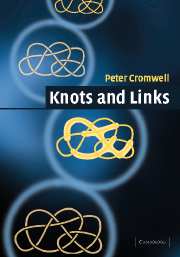Book contents
- Frontmatter
- Contents
- Preface
- Notation
- 1 Introduction
- 2 A Topologist's Toolkit
- 3 Link Diagrams
- 4 Constructions and Decompositions of Links
- 5 Spanning Surfaces and Genus
- 6 Matrix Invariants
- 7 The Alexander–Conway Polynomial
- 8 Rational Tangles
- 9 More Polynomials
- 10 Closed Braids and Arc Presentations
- Appendix A Knot Diagrams
- Appendix B Numerical Invariants
- Appendix C Properties
- Appendix D Polynomials
- Appendix E Polygon Coordinates
- Appendix F Family Properties
- Bibliography
- Index
7 - The Alexander–Conway Polynomial
Published online by Cambridge University Press: 05 June 2012
- Frontmatter
- Contents
- Preface
- Notation
- 1 Introduction
- 2 A Topologist's Toolkit
- 3 Link Diagrams
- 4 Constructions and Decompositions of Links
- 5 Spanning Surfaces and Genus
- 6 Matrix Invariants
- 7 The Alexander–Conway Polynomial
- 8 Rational Tangles
- 9 More Polynomials
- 10 Closed Braids and Arc Presentations
- Appendix A Knot Diagrams
- Appendix B Numerical Invariants
- Appendix C Properties
- Appendix D Polynomials
- Appendix E Polygon Coordinates
- Appendix F Family Properties
- Bibliography
- Index
Summary
So far, the invariants we have seen have all been numerical – either geometrically motivated or resulting from a computation. In this chapter we shall introduce polynomial-valued invariants. First we shall derive the classical Alexander polynomial from the Seifert matrix. The Conway polynomial has an axiomatic definition based on relationships between diagrams. In spite of their different origins, a change of variable shows that these two polynomials are actually only one invariant. The Alexander viewpoint allows us to obtain a lower bound on the genus of a link, while Conway's algebra of tangles explains some of the symmetry properties of the polynomial.
The Alexander polynomial
Definition 7.1.1. The Alexander polynomial of an oriented link L, written variously as Δ(L) or ΔL(x) depending on the required emphasis, is the determinant det(xM − x−1MT) where M is any Seifert matrix for L. It is a Laurent polynomial in ℤ[x±1], that is a polynomial in positive and negative powers of x with integer coefficients.
As with the determinant and signature definitions, it is not obvious that the Alexander polynomial of a link is independent of M. The proof that it is well-defined is essentially the same as the proof of Theorem 6.6.5.
Theorem 7.1.2.Let M be a Seifert matrix constructed from a surface F spanning an oriented link L. Then det(xM − x−1MT) is a link invariant.
- Type
- Chapter
- Information
- Knots and Links , pp. 157 - 188Publisher: Cambridge University PressPrint publication year: 2004



